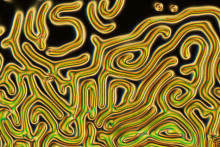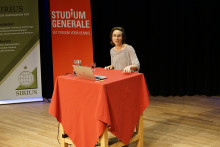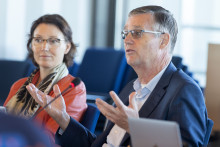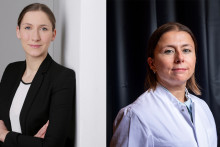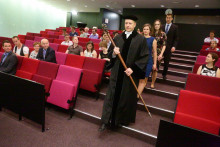The lecture titled 'Beauty of Science' took place on the 3rd of November 2015. It provided platform for scientists from Young Academy @UT to showcase the beauty of their respective fields, as well as the science in general.
Numbers as building blocks of life
What is beauty? Is it the perfect form, structure or color? According to Saskia Lindhoud, a researcher in the field of nanobiophysics, the answer might lie in mathematics and so called 'golden ratio'. The golden ratio (or golden section) is a special number that appears suspiciously often in geometry, architecture and nature.
'The golden section can be found in the whole universe - everywhere from flower petals and arrangements of seeds, to spiral galaxies. Egyptians as well as Greeks based their architecture on it. Pythagoras even believed that numbers are the building blocks of everything. Things that have properties of the golden section, people perceive as beautiful,' explained Lindhoud. 'For me, beauty is understanding the origin of life.'
Liquid crystals
Nathalie Katsonis, the next speaker of the night, also sees beauty in the search for hidden answers. 'As a material chemist, I´m imagining new materials. Now we are working on creating smart materials of the future, materials that are self-healing and adapt to changes. For that we use liquid crystals that have interesting optical properties,' said Katsonis. 'They form beautiful images in the lab and their beauty actually disguised their usefulness for some time. At first, they were seen only as a laboratory curiosity that produces nice shapes and colors and their uses weren´t discovered until decades later.'
Besides from being a base for a multimillion industry, liquid crystals have also found their place on the art scene. Artist Gustav Metzger used liquid crystal light projections for his auto-creative art, pictures that were creating themselves while different temperatures were applied to the crystals.

The power of doubt
Do liquid crystals represent the beauty of science? Nathalie Katsonis doesn´t think so: 'Beauty is not in symmetry, color, shape or usefulness. It is in what the object reminds us of. I find pictures drawn by my little son beautiful, but nobody else does. It is the associations that make things beautiful. Beauty exists only in our minds. And scientists´ minds are driven by search for hidden beauty, we want to be the ones who discover it. Why? The power of doubt that each scientist has. The feeling of doubt that there is more to life than we can see.'
'We meet a lot of people, including scientists, who think they know the truth,' concluded Katsonis. 'But it is important to remember that nobody really knows.'
Creating reality
Professor Alexander Brinkman definitely didn´t argue with that statement. 'We understand very little about the universe,' he said as he took the stage. '96% of the universe consists of matter we don´t understand yet, of particles we don´t know.'
That also applies to quantum physics, Brinkman´s field of expertise. 'We still don´t know why things behave the way they do. We know of strange correlations, but we don´t know why they exist,' said Brinkman. ' In quantum world, properties of a state only exist after you measure them. Until then, all properties exist at the same time. Therefore scientific modeling and measuring of the reality, actually creates the reality. That is the beauty for me - creating reality by doing measurements.'


